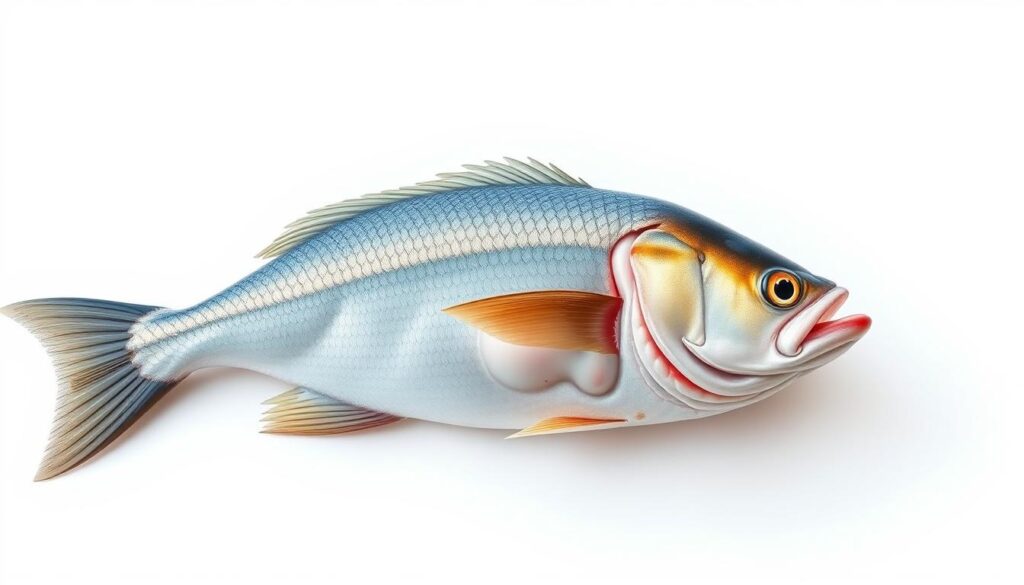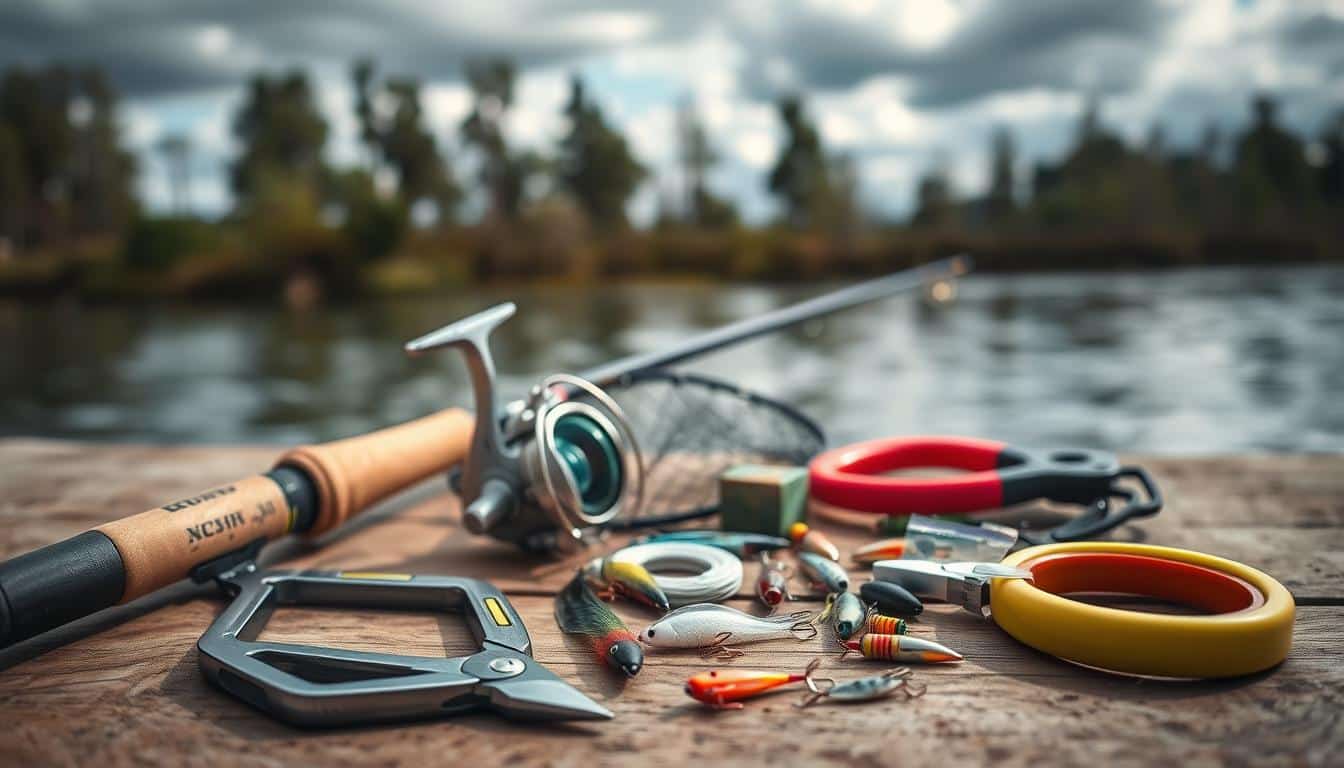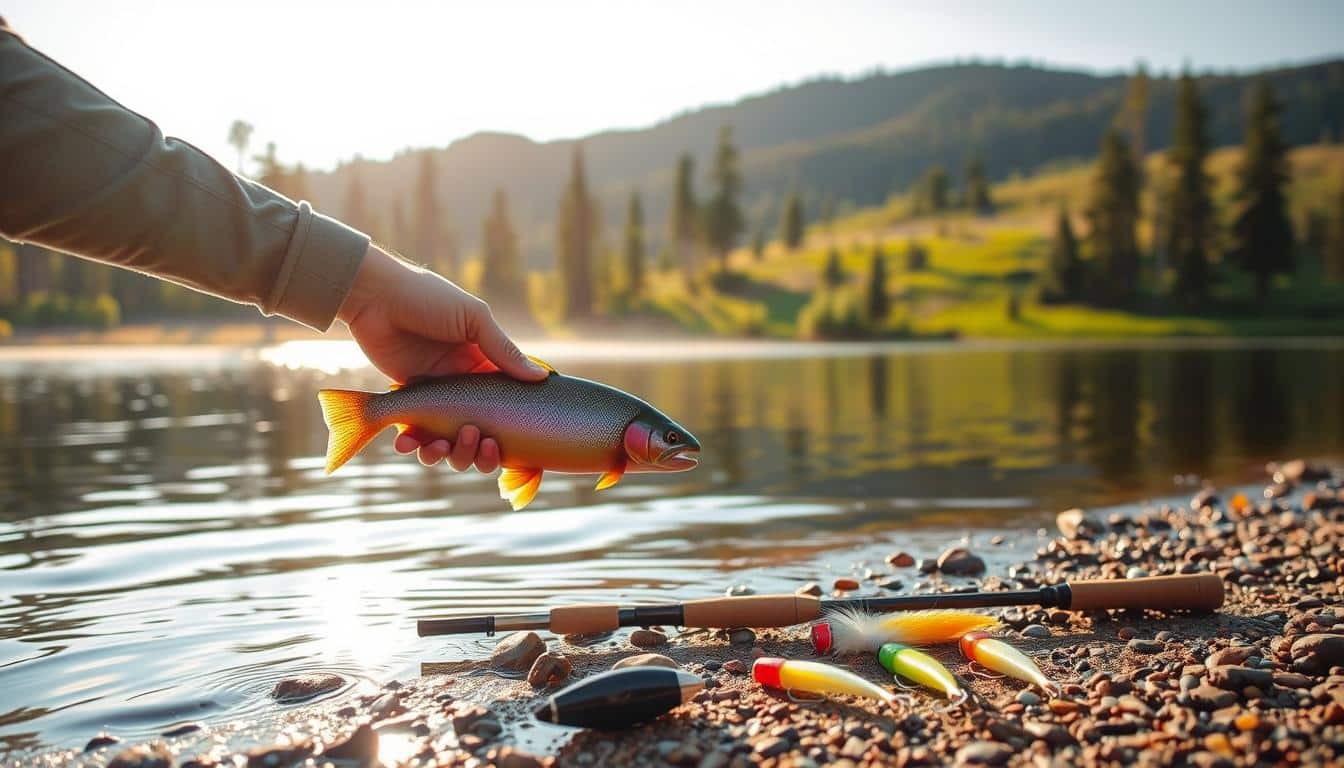Catch and release is about putting fish back after you catch them. It helps keep fish populations healthy by saving more fish to breed. By doing this the right way, fish numbers can stay strong, which is great for fishing in the future.
Just throwing a fish back doesn’t mean it will survive. The way fishermen handle fish from start to finish is key. Using the right tools, touching the fish less, and keeping it out of air matters a lot.
When all anglers fish this way, everyone wins. Good catch-and-release practices help keep fish laws effective. They assure fish will be there for kids and grandkids to catch too.
What is Catch & Release: Reducing Stress on Fish
Catch and release is about quickly returning a caught fish back to the water. It aims to minimize harm and keep the fish alive. Anglers practice this to help protect fish populations while enjoying their hobby.
Definition and conservation purpose
Catch and release means capturing a fish, then letting it go so it can continue living. Its goal is to keep ecosystems balanced by preserving fish. This way, fish have the chance to reproduce and grow, benefiting future fishing.
How proper catch-and-release sustains fisheries and angling opportunities
Doing catch-and-release right increases the chances of fish survival. This helps make fish management strategies work better. Research on several fish species shows that careful handling leads to better survival rates. This also helps sustain fishing for both fun and business.
Common misconceptions about simply releasing a fish
Many think just releasing a fish ensures it survives. Yet, stressors like exhaustion, deep hooking, or poor water can lead to death later on. Mistreating a fish, even when quickly released, can still harm its chances of survival.
Fish caught deep need special care, like cutting the line or using certain tools. Knowing the right actions to take can reduce harm. This knowledge supports the main goal of catch and release conservation.
Causes of Stress and Injury During Capture
When anglers know what harms fish during capture, catch-and-release can protect fisheries. Stress and harm often come in ways we can see coming. By knowing these risks, anglers can pick gear and ways to fish that make landings faster and fish more likely to survive.
Physiological toll from prolonged exertion
Long fights increase lactic acid in fish muscles and blood. This buildup leads to tiredness and blood chemistry issues. Tired fish need oxygen right away. Choosing the right tackle for the fish you’re after makes fights shorter. This reduces chances of muscle trouble or death.
Harm from where the hook lodges
Where a fish gets hooked matters. Mouth hooks often heal okay if handled right. But hooks in the gills or belly can cause serious bleeding and infections. Research shows certain fish types die more from throat or belly hooking. If a hook is swallowed deep, it might be best to cut the line and leave the hook.
Environmental pressures that worsen outcomes
After being caught, fish deal with major environmental stresses. High water heat, low oxygen, and bad water quality are big issues. In shallow, hot, or still waters, fish struggle to recover. Fishers should steer clear of harsh conditions. And be smart about local water flows and oxygen levels when letting fish go.
- Match your tackle to the fish to shorten fight times and lessen lactic acid buildup.
- Use circle or barbless hooks to reduce serious hooking harm.
- Don’t fish during times when environmental stresses like high heat or low oxygen happen.
Choosing Fish-Friendly Gear to Reduce Harm
Choosing the right gear helps reduce injury and improves fish survival upon release. Small changes in what you choose from your tackle box can make a big difference. They affect where the fish gets hooked, how long the battle lasts, and what you need to do to handle them. Always pick tools that let you handle the fish fast and aim to keep them in water.
Benefits of circle hooks and barbless hooks for reducing deep hooking
Circle hooks are made to avoid the fish’s throat, hooking them in the mouth’s corner instead. This greatly cuts down the chance of deep hooking in many fish types, including bluefin tuna and striped bass.
Barbless hooks cause less harm and make it easier to remove the hook. If you make your hook barbless by compressing the barb, you won’t have to change how you bait your hook. Pairing circle and barbless hooks together means less damage to fish and quicker release times.
Use of non-stainless hooks, sharp hooks, and appropriate tackle strength to shorten fights
Non-stainless hooks like those made of steel or bronze break down faster than stainless ones. This is good for fish that swallow hooks deep since the hook will eventually corrode. It means less harm in the long run.
Using sharp hooks helps in catching fish quickly as they pierce faster, avoiding long fights that tire out the fish. It’s important to choose the right strength of tackle for the fish you’re aiming to catch. Oversized line can needlessly prolong the struggle. If a fight takes too long, consider using stronger gear to finish it quicker and reduce the fish’s stress.
Nets, landing tools, and dehookers: wet, knotless rubber nets and tools that minimize handling
- Opt for rubber landing nets or those coated in rubber with a knotless design to protect the fish’s protective coating.
- Have tools like long-nose pliers, forceps, or specialized dehookers ready to remove hooks with minimal fuss.
- Use wet gloves or a damp cloth to hold the fish and, if possible, remove hooks while they’re still underwater to lessen exposure to air.
Small changes like using circle hooks, having dehookers handy, and using rubber nets can really help. These choices lessen injuries, speed up handling, and make catch-and-release fishing more effective.
Handling Techniques That Improve Survival
Using good handling techniques seriously helps fish survive after you release them. Simple actions can lower injury and stress for the fish. This makes the whole fishery healthier in the long run.

Always wet any surface that touches the fish first. This includes your hands, gloves, towels, and nets. Keeping the mucus layer intact is crucial for preventing infections.
Touch the fish carefully and for a short time only. Stay away from the eyes and gills since they’re very delicate. When using tools, act fast to get the fish back into the water quickly.
-
Wet your hands or gloves before handling the fish to keep its slime layer safe.
-
When landing the fish, use a wet, knotless rubber net to lessen the loss of scales and slime.
-
Don’t rub, squeeze, or put the fish on dry surfaces.
Try to keep the fish out of air for no more than 60 seconds. Taking photos, weighing, or examining it for too long harms the fish. If you can, unhook and measure the fish while it’s in the water.
When you hold the fish, keep it horizontal. Put one hand under its belly and the other near its tail. This protects its insides and stops injuries. Never hang the fish by its jaw or lift it by the fishing line. That can harm its bones and soft parts.
-
Hold fish sideways with both hands. This spreads out the pressure and prevents damage.
-
For big fish, keep them next to the boat without pulling them out completely.
-
If you can’t let the fish go right away, keep it half in the water and its gills moving.
Making small changes when handling fish improves their chances of survival. Adopt these methods to ensure the fish and fisheries last for years to come.
Unhooking, Gut-Hooked Fish, and When to Cut the Line
Quickly taking action after catching a fish can reduce its stress and help it survive. It’s best to use unhooking methods that keep the fish out of water for as little time as possible and don’t damage its body. Have your tools ready so you can either remove the hook smoothly or decide to cut the line quickly.
Safe removal tools and technique
- Always bring long-nose pliers, dehookers, or special hook removers to make taking out hooks easier and faster.
- If the hook is in the fish’s mouth, gently follow the path it went in and ease it out slowly. This prevents injury.
- Try to remove the hook while the fish is still in the water if you can. Using pliers instead of your hands is safer and quicker.
Deciding to cut the leader
If the hook has gone in deep, trying to pull it out can seriously hurt the fish. Research on fish like snook has found they’re more likely to die if we try to force out a deep hook. In these situations, it’s better to cut the line near the hook and let the fish go right away.
- For fish that are gut-hooked, it’s kindest to handle them less and cut the line to prevent more injury.
- Leave a bit of line so the hook stays in while the fish gets better and can heal.
Hook composition and long-term effects
The type of material a hook is made of impacts the fish’s chances of survival. Hooks made from steel or bronze break down faster in the water, which is better for the fish. However, stainless-steel or coated hooks don’t corrode easily. This means they could hurt the fish for a longer time. So, choose your hooks thoughtfully, considering how they break down, if releasing fish safely matters to you.
Field checklist
- Quickly figure out where the hook is: in the mouth, gill, or gut.
- Use the gentle back-out method for mouth hooks, with tools like pliers or a dehooker.
- If the hook is swallowed deep, cut the line near the end and set the fish free right away.
- Think about what the hook is made of. Choose ones that won’t harm the fish in the long run, especially if you plan to release it.
Dealing with Barotrauma and Deep-Caught Fish
Fish caught from deep waters may have barotrauma. Signs include bulging eyes and a bulging belly. Their scales may lift, and they might move slowly.

Use quick release methods to help them survive. Devices that lower the fish quickly are effective. These tools are tested and stress the fish less.
-
Descender devices: These hold a fish and lower it safely. They work well from a boat and are easy to use.
-
Release weights: This method uses a weight to send the fish down. The weight comes off or is pulled back up afterwards.
-
Release baskets: They gently lower the fish and stop more harm during the descent.
In some cases, when you can’t recompress, venting is okay. Do it right. Use a short, hollow needle. Insert it carefully behind the fin at a slant. Stop if you hit anything hard. Don’t push an everted stomach back inside.
Decide on venting based on the fish type. Groupers and some reef fish can handle venting well. But thin snappers might get hurt. They’re often safer with quick back-to-depth methods without venting. Use the right technique for each fish type.
Always try to handle the fish little and act fast with the proper equipment. Knowing how to spot barotrauma and using the right tools and methods can save these deep-sea fish.
Resuscitation and Safe Release Techniques
Acting quickly and calmly after catching a fish is crucial. It affects their chance of surviving after release. Handle the fish gently and let water run through its gills. This helps it breathe. Make sure to use the right release methods for each fish type. Also, choose a release spot with enough depth, flowing water, and places to hide from predators.
How to revive exhausted fish
- To help tired fish, face them into the current or gently push them forward. This gets oxygen to their gills and helps them breathe.
- Hold the fish’s tail gently and support its body. This avoids hurting its spine. Try to encourage slow and steady tail movements.
- If a fish can hardly move, open its mouth a bit by pressing its lower jaw. Move it slowly in the water but don’t do it for too long. This could stress the fish more.
When to spend extra time versus when to release immediately
- Give more help to fish that can’t stay upright, have weak gill movements, or float away when let go.
- Let the fish go quickly if it tries to swim away strongly or seems to get better fast. This reduces the stress of handling.
- Don’t try too long to revive a fish. It could end up hurting them more than helping.
Release site selection
- Pick a deep spot with lots of oxygen and moving water. It helps tired fish get strong again quickly.
- Look for shady spots or places with lots of cover. These help fish hide from predators while they recover.
- If a fish is hurt by pressure changes, use tools to take them back deep if you can. If not, let them go in calm, safe places where they won’t be easy targets for predators.
By following these steps and releasing fish carefully, we help keep fish populations healthy. It ensures fishing can be enjoyed by others in the future.
Education, Regulations, and Best-Practice Culture for Anglers
Fishing isn’t just about being good with a rod. Knowing how to handle fish and understanding clear fishing rules play a big part. When anglers develop these good habits, fish are more likely to survive after being released. This makes rules like bag limits and size limits work better.
Why rules matter in practice:
- Fish managers set limits to control the number of fish caught and ensure they can reproduce. But, if too many released fish die, these limits don’t help much.
- When areas are closed off for fishing during certain times, it’s to help fish populations grow. This only works if the fish that are caught and released live.
- Some fishing rules may ask for specific equipment or techniques that lower the chance of harm or stress to fish.
How to pass skills along:
- Encourage the use of circle and barbless hooks, holding fish with wet hands, and keeping them out of water for short periods.
- Demonstrate the right way to unhook fish using long-nose pliers and how to help deep-caught fish return safely using descender devices.
- Set a good example for children and beginners so that these safe practices become common.
Know and follow local guidance:
- Some places have rules like needing to let air out of fish or using circle hooks for certain big fish.
- State agencies, like Florida Fish and Wildlife, have their own guidelines. Always check these before fishing.
- Following these special rules not only avoids trouble with the law but also keeps fish stocks healthy for later.
Building a culture that promotes best practices connects angler knowledge to better results. When anglers teach each other and stick to the rules, limits on the number and size of fish caught work as they should. Having clear rules and acting responsibly ensures our fisheries stay healthy for all.
Conclusion
Catch and release, when done correctly, helps protect fish and keeps fishing fun for everyone. Using the right hooks and handling fish carefully reduces harm. Simple steps like using the right nets can increase a fish’s chance of survival.
Fishing responsibly means handling fish quickly and safely. Keep fish out of air for less than a minute. Use tools like pliers to remove hooks gently. If a fish swallows a hook, sometimes cutting the line is best.
How anglers handle fish affects their survival more than just releasing them. Follow the rules, teach others, and use the best methods for releasing fish. Planning your gear and how to handle fish can make fishing more sustainable.
Every angler should aim to fish responsibly. Learn how to handle different fish, follow the rules, and share your knowledge. This way, we can all enjoy fishing for many years to come.
FAQ
What is catch-and-release and why is it used?
Does releasing a fish always guarantee it will survive?
How does prolonged fight time harm fish?
Which hooking locations are most harmful to survival?
What environmental conditions increase post-release mortality?
How do circle hooks and barbless hooks improve survival?
Should anglers use non-stainless or stainless hooks?
What nets and tools minimize harm during landing and release?
How should I handle a fish to protect its slime and gills?
How long can a fish safely be out of the water for photos or weighing?
What is the safest way to remove a hook?
If a fish is gut-hooked, should I cut the line or try to remove the hook?
What are signs of barotrauma and why do they matter?
How can I treat barotrauma-affected fish?
When is venting appropriate and how should it be done?
How do I revive an exhausted fish before release?
When should I spend extra time resuscitating a fish versus releasing immediately?
Where should I release a fish to maximize its chance of survival?
How do catch-and-release practices support fisheries management?
What should I teach new anglers about catch-and-release?
Are there local rules I must follow when practicing catch-and-release?
What simple gear choices can I make right now to improve survival?
Where can I find research-backed guidance and species-specific protocols?
Content created with the help of Artificial Intelligence.



